Pillow of Death, Strange Confession, The Frozen Ghost (1945)
Directed by: John Hoffman, Robert Young, Wallace Fox
Written by: Bernard Schubert, Dwight V. Babcock, George Bricker, Jean Hart, Luci Ward, M. Coates Webster
Starring: Brenda Joyce, Evelyn Ankers, Lon Chaney Jr.
ON BLU-RAY 18TH JANUARY, from EUREKA ENTERTAINMENT
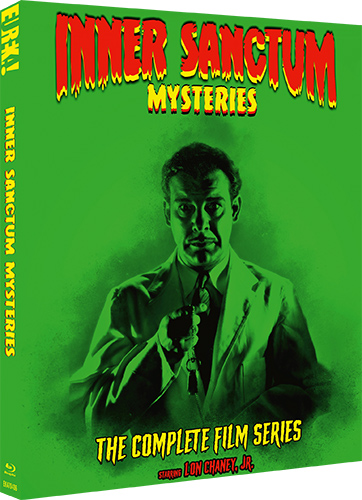
THE FROZEN GHOST [1945]
RUNNING TIME: 61 mins
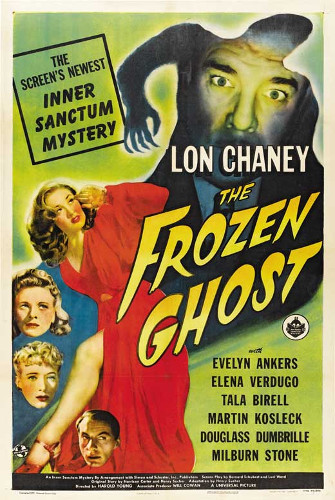
During one of his shows, mentalist Alex Gregor hypntises a rudely sceptical audience member, but the man dies. The medical examiner concludes that the drunken person died from a heart attack, but Alex is riddled with guilt and breaks off his engagement to his girlfriend and assistant, Maura Daniel. Alex’s manager George Keene arranges for him to work as a lecturer at a wax museum ran by Mme Valerie Monet, whose niece, Nina Coudreau, is happy to have Alec around. However, sculptor Rudi Poldan, a disgraced plastic surgeon after Nina, is not so happy…
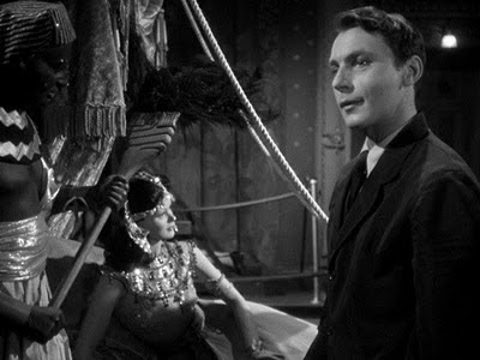
The fourth Inner Sanctum Mystery [which doesn’t have a ghost in it despite what the title may lead you to believe] rehashes elements of the first and third entries; plotting and situations in those are repeated, from hypnotism being used to resolve the plot to Chaney’s character dumping his fiancee. There are also some notable plot holes which I won’t mention here because it would be giving too much away, but which shows that less care was taken with the script – written by Bernard Schubert and Luci Ward from a story by Harrison Carter and Henry Sucher – than on the previous entries which, while not being particularly noteworthy, did have pretty tight plotting. But on the other hand it does have a great setting which is used really well. Wax museums were of course a common setting for horror in the old days, 1933’s genuinely classic The Mystery Of The Wax Museum setting a standard which was never really matched by any successor, not even its 3D remake which had the bonus of Vincent Price. However, most of these films make some effort to make the most of the locale and this one stages many of its scenes amid waxwork figures, figures which often look as if they’re commenting on the action. The gimmick of having the bodies of murder victims disguised so they look like figures to avoid discovery is also employed, though it’s rather daft that the killer does this seeing as there are two other people working in the museum ignorant of his actions who knew the first victim well and would surely recognise this person among all the waxworks.
Anyway, a slow zoom into a poster for Alex’s act has the face of Maura on it dissolve into the face of the real Maura. Alex hypnotises her and then she can tell things like people’s security numbers and their thoughts. A blotto nuisance cries out that this isn’t real, so Alex hypnotises him on stage, with disastrous results, though a result that has nothing to do with Alex. I personally wouldn’t have though that working in a wax museum would be the thing that this tormented person should be doing, but he does it anyway, in a place that typically has murder and execution tableau along with the usual suspects like Genghis Khan and Cleopatra. Boss Valarie seems nice enough, and her niece Nina even nicer ,the girl worshiping Alex. Once again Chaney is playing a babe magnet and I do sometimes wonder if he specifically requested this. Rudi dislikes Alex though and keeps pestering Nina. Then Maura reappears and attempts to woo Alex back. Jealousy spreads, infecting Valerie, who falsely accuses Alex of making advances to Nina, her niece. Arguments ensue, Valarie faints – and then disappears. Police Inspector Brant suspects that Valerie has been murdered, believing Alex to be the last person to have seen Valerie alive, but you won’t be surprised to learn that Rudi is really the one up to no good, probably as soon as you’ve seen him talking to the figures. Well, he’s one of the people up to no good – a revelation near the end may surprise some but curiously I guessed it. Watching several films of this sort in fairly quick succession must have improved my detecting skills. We get a good stalking sequence involving Alex and Rudi which might be the most suspenseful set piece in all these films [well, so far anyway], a memorable though highly predictable death for one of the two villains, and the usual pat wrap-up, though this one has a nice final exchange which may or may not have been intended as a commentary on these films.
As with Calling Dr. Death, some material seems awfully like padding despite the running time being so brief. Fortunately though some of it features by far the best of the nosey cop characters we’ve seen so far. Inspector Brant, nicely played by Douglas Dumbrille who was usually busy playing crooked characters, quotes Shakespeare, doesn’t think much of paintings of flowers, and has to straighten every single piece of art hanging on the wall that he sees. Chaney is fine but essentially repeating previous things leaves his performance lacking the surprising freshness that he had in earlier installments, and he and Evelyn Ankers, in the last of their eight shared films, just seem to be going to the motions in their scenes together. What is it with his ties in these films though? Was it in his contract that he wear a garish one every time so that your attention is more drawn to him than it may otherwise be? I had a feeling that Reginald Le Borg, who directed the first three, would be sorely missed in the last three, and that’s partly the case in this one. I say “partly” because Robert Young, along with cinematographer Paul Ivano, do provide us with some nice visual flourishes, like a scene of hypnotism having extreme close-ups and spirals, though there are only a few of these and overall the style is more run of the mill, or would be without the prime setting. On the other hand there are only two moments of Chaney voiceover which is probably an improvement, and the first instance works rather well as his weary tones are heard over shots of his legs as he wonders about for ages, trying to his head straight. A few new music cues [from four other composers] are heard too and make a nice change from hearing virtually the same work from Paul Sawtell in each film. The Frozen Ghost still succeeds as much as it does primarily because of its wax museum principal setting, but that’s absolutely fine, even if the formula may have already been getting a little stale – which must be why they changed it somewhat for the next two films.
SPECIAL FEATURES
Trailer
STRANGE CONFESSION [1945]
RUNNING TIME: 61 mins
Carter is a chemist working for unprincipled pharmaceutical tycoon Roger Graham, who takes the profit, as well as the credit, for Jeff’s discoveries and hard work. When Graham prioritises profits over safety, Jeff resigns and is blacklisted by his boss. He finds a job working at a chemist by day while working on a vaccine for influenza at night, though his wife Mary wants more of the finer things in life. When a seemingly chastened Graham turns up with an offer to rehire him, Jeff agrees. But Graham wants to release this influenza drug before it’s been properly tested, something that Jeff is opposed to….

“What’s in the bag” is one of the first things I asked myself when watching this one. Jeff turns up at a lawyer friend’s house carrying a bag with something in it, something horrible judging by the look on the lawyer’s face when the bag is opened for his benefit. However, we never find out what it is, though I made an educated guess even before I found out that Strange Confession is a remake of a 1934 effort called The Man Who Reclaimed His Head. That one starred Claude Rains, both being based on a play by Jean Hart. In both versions, there’s some psychological stuff about the taking over of a person’s head by someone else, though it seems like the earlier version is a bit more obvious about the eventual taking of the premise to physical extremes. What with all the talk of vaccines at the moment and the worries many have about possible side effects, it was a tad disconcerting viewing the fifth in the series, as well as disappointing that it was the furthest from horror than all of the previous films and not much of a thriller either, though the reason it was rarely shown on TV alongside the other Inner Sanctums was due to a copyright dispute about it being an unauthorised remake. However, thinking about it retrospect as I type, it was a pretty strong drama with solid writing and performance, even if the direction almost entirely lacks style. Chaney might be the best he’s ever been in this series, and there even seems to be a rather timely message about tighter regulation of the drug industry and criticism of big pharma, though it’s a very downbeat story, its hero repeatedly having bad things happen to him and being tricked and mistreated by the villain. This is one thing that makes it the closest to film noir out of all of them, despite the relatively staid visual approach.
In fact the viewer-grabbing opening is right out of a classic noir. We see a man sneaking out of an apartment, trying his best not to be seen. As we realise that it’s Chaney and therefore our ‘hero’ Jeff, he arrives at a house and knocks on the front door before begging to the owner to listen to his story. An old friend of his, he only deals with big league cases, but he’ll give Jeff an hour within which to tell his tale. Just before Jeff does this, the lawyer tells his servant to, “call the police, his mind in unbalanced”, though none turn up so I guess they were very busy on this night. In flashback, we immediately pick up on Jeff being a humble person who doesn’t seem to be that bothered by his boss Roger taking all the credit and money for his hard work as well as his ideas; it’s enough that he’s done said work. We even seen Roger reading out a speech that Jeff wrote for him even though the speech is about something that Jeff’s done but nearly everyone will think it was done by Roger. The thing that’s most important to Jeff is his family; we see him sneakily giving his son Brandon some sweets and Mary, who thinks that it’s amazing that Brandon settled down so quickly, doesn’t realise this. But Jeff eventually walks out on Roger because Roger wants to sell a drug that hasn’t been fully tested. Roger responds by blacklisting him. Jeff works in a chemist for the next few years but Mary isn’t satisfied with their fairly frugal life. Roger eventually gets Jeff back so he can work on his vaccine in a proper laboratory, but Jeff discovers that he needs a plant ingredient in South America to complete his task. Seeing that Jeff won’t release the drug otherwise, Roger decides to let Jeff go to South America and get him to stay there while he releases the unfinished version of the vaccine anyway and also sets his sights of Mary. A tragedy ensures which I didn’t expect to happen and there’s a pretty strong moment of implied violence, a multiple hacking with a scythe while the person watching feints.
Chaney was generally a very ‘external’ actor like, say, Kirk Douglas, though he’s a bit more subtle here in some scenes and quite nicely plays the family man. We really like his character which makes his exploitation by Roger all the more upsetting. J. Carroll Naish played the nagging cop in Calling Dr. Death but is here in a more typically villainous role. He’s magnetic in the part and you can see why people work for the character despite seeming very hard to please. Everyone is good in this, including a young Lloyd Bridges who’s visibly struggling with some weak ‘comic relief’ material but still manages to please, so I’d say that director John Hoffmann was one who was good with actors but otherwise content to just film scenes as written and not add any of his own input. The film isn’t exactly flat visually, but it’s so notably different in this respect to the previous episodes, another reason why it’s falls outside the others a little. In some respects it’s a hard one to sum up. Nothing exciting happens until the end, yet the tragic story really compels and I feel that this could have been a minor classic if some aspects weren’t held back on. For example there’s Mary. She’s well played by Brenda Joyce who was Jane in some of the Tarzan flicks, but I wish that the script by M. Coates Webster had gone a bit further with the character’s ambiguities. Mary basically pushes Jeff into working for the evil Roger again, and could therefore be said to be responsible for later developments. She even seems to provide some slight encouragement to Roger; censorship of the time obviously prevented that subplot from explicitly developing in the direction in which it seems like it will do, but they could have found ways around it. Still, this is a stronger and more interesting entry than it might sound, with a fine and well employed music score by Frank Skinner too.
SPECIAL FEATURES
Audio Commentary from screenwriter Peter Atkins and screenwriter/film historian C. Courtney Joyner
For his second commentary track in this set, Joyner, who considers this one to be the best film in this series, is joined by Peter Atkins, sounding rather faint on his digital hook-up so you may have to adjust the volume continually while you listen. Apart from that though, this is another fine track. Joyner has the information but Atkins supplies the insight, and even criticises the screenplay at one point while saying that the story could have worked better as a much shorter endeavour. We learn a fair bit about The Man Who Reclaimed His Head including that Jean Hart was a woman using a pseudonym, hear a wonderful story that Chaney Sr. told to his son about a family Christmas, and even have some discussion about influenza!
Trailer
PILLOW OF DEATH [1945]
RUNNING TIME: 66 mins
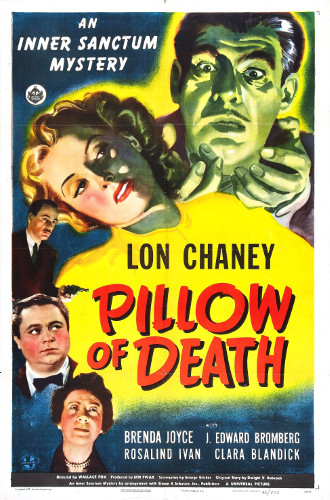
Attorney Wayne Fletcher and his secretary Donna Kincaid are having an affair, something which doesn’t much please her mother Bella. Wayne promises Donna that he’s going to talk to his wife about a divorce, but returns home to find that she’s been suffocated to death with no visible signs of a struggle. Police Captain McCracken immediately suspects Fletcher and arrests him, though he’s later released through lack of evidence. In the Kinkaid household, Bella holds a seance where medium Julian Julian supposedly contacts Donna, but what are Julian’s motifs, why does neighbour Bruce Malone keeps on sneaking into the house, and why does Wayne start to hear his dead wife calling to him….
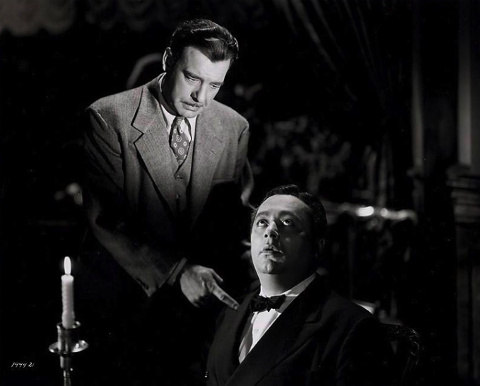
Well, this certainly turned out to be a surprise. The eighth and final Inner Sanctum Mystery turned out in my mind to be the very best. Of course this may partly because I do like old dark house mysteries and this one contains many of the elements that you expect such as murder, a strange family, and a hidden room [no will though], while also providing a surprise-filled plot, especially succeeding with its conclusion which really knocked me for six. While not ignoring the necessary atmosphere, director Wallace Fox certainly doing well in creating plenty, it’s also the fastest paced of all the films, the darkest, and possibly even the creepiest despite the fact that we remember from the previous ones that the supernatural doesn’t really exist – well, except for Weird Woman which sort of hints at the possibility though you could easily explain away its story line while remaining within the bounds of the plausible. Pillow Of Death has seances and ghosts, and one can’t help but wish that screenwriters Dwight V. Babcock and George Bricker had delved into the possibilities of these ingredients and potential fantastical pathways for its story, but despite that there are probably more horror moments than in any of the others, most notably one just after half way through which must be the most effective sustained sequence of the entire series, where Chaney’s character Wayne hears his dead wife’s voice calling him and follows the sound into a cemetery where the mausoleum containing her coffin lies. Even though the cemetery doesn’t look very real [maybe some fog might have helped in disguising its short comings while still maintaining the feeling of artifice?], one is genuinely riveted and even a little frightened.
First of all we’re introduced to Donna’s family; mother Bella, uncle Sam, and English relative Amelia, who amusingly is mostly used as a servant by the other two. The bickering between Bella and Sam is also funny, the latter played by George Cleveland in a fine comic performance. Sam wants his food above everything, makes a show of liking Wayne despite the others feeling the opposite and not at all liking Donna running around with this married man, and calls a seance, “the silliest unmitigated tommyrot I’ve ever heard”. When a search for the ghost of an Uncle Joe instead reveals a raccoon, he remarks, “looks a bit like Uncle Jos at that, but the ears are different”. As with many of the best of the films of this genre, the humour doesn’t get in the way and it’s almost disappointing that it disappears in the final third. Wayne is soon suspected of murder as usual but this time he’s actually taken away and thrown into a cell, allowing Captain McCracken to be the character that we’re chiefly with for a while. He and we both quickly find Julian Julian to be very suspicious, and not just because it’s very likely indeed that he’s really a fake one. J. Edward Bromberg who plays him rarely lets down a sly smile and the character always seems to be in control. One of his best moments is when he also becomes a suspect so he turns himself in voluntarily. Also suspicious is neighbour Bruce who’s first seen peaking in through a window and whom we soon learn is able to come in and out of the house without anybody else seeing him. It’s revealed that he has a real thing for Donna, and he claims that he’s keeping an eye on her for her protection, but surely he’s hiding something? The reveals pile up as more murders also take place at a speed which is quite surprised me, until we get a climactic reveal that’s very well handled so that you question it a little and actually hope that it isn’t the truth until you come to terms with it. The only part of the tale that doesn’t really work is the nature of the murders; it’s patently obvious what it’s going to be considering the film’s title!
The Fletcher household is often said to be haunted and it seems that the family aren’t particularly bothered by this fact, yet it’s amazing how the sounds of chains and a voice can almost always unsettle just a little even if you know they’ll probably turn out to be fake. The set, while not reaching the heights of the very best examples, is still quite impressive even if it was left over from another film. Cinematographer Jerome Ash is much like his immediate predecessor in that he doesn’t go in for elaborate visuals, but his camera sometimes glides about nicely and on several occasions invites us to look into darkness and dare to see what’s beyond it. Brenda Joyce isn’t too good second time around but Chaney truly shines in what in some ways is the most interesting of his parts in these films. Chaney has generally been considered second fiddle to Boris Karloff and Bela Lugosi but, while he wasn’t really capable of the subtlety of the former nor the otherworldliness of the latter which made him fit so well into the horror genre, he was good at projecting an ‘everyman’ quality despite his very brawny beard, something which means that, in all of these films he’s able to grab and maintain the viewer’s sympathy while still slightly unsettling us with the idea that, while it’s doubtful that he’s guilty of the killings that are going on, all of us may have a dark side which has the potential to go out of control. I’ve never really been a fan unlike I’ve been of Karloff or Lugosi, but he’s certainly risen in my estimation due to these six films and is a major reason for them working as much as they do. Pillow Of Death is a surprisingly satisfying melding of mystery, horror and humour that I wished was actually longer, even though there isn’t really anything in it which needed more time spent on it.
DISC TWO SPECIAL FEATURES
The Creaking Door: Entering The Inner Sanctum [15 mins] – History of the Radio Series with author/radio historian Martin Grams Jr.
Also on the Mill Creek release, this featurette even contains some footage of the programme being recorded along with lots of interesting tidbits such as the sound of the creaking door was copyrighted so no other series of even film could use it. The series apparently began emphasising horror, then mystery before settling on a format that usually contained a tortured soul telling his own story Edgar Allan Poe-style.
Mind Over Matter [20 mins] – Archival interview with actor Martin Kosleck [The Frozen Ghost]
This Mill Creek extra has the Soviet actor discuss his early career, much of which was spent playing Nazis until Basil Rathbone picked him to appear opposite him without even suggesting an interview. Asked about Chaney, he replies, after some hesitation,“the most dreadful, old, rude drunk I have ever seen in my life” .
Inner Sanctum Mysteries: Radio Episodes – A selection of episodes from the original radio series
Three more episodes, this time employing said first-person narrative format, along with advertisements for Lipton Tea and the usual bad puns from our host.
Skeleton Bay 30 mins]
The story-telling device is certainly put to good use here, the result being a wonderfully dark and twisted tale that only suffers from being rather too abrupt in some places, as if the short running time couldn’t really hold it. The main character is an unnamed female writer of mysteries who sees a murder being committed right before her eyes, a scene so well described and full of atmosphere one can really conjure up the appropriate visuals. Instead of the usual response, she hides the body in her closet and befriends and falls in love with the killer, even becoming a murderer herself. There’s one of those wonderful detective characters who’ve read all the stories our protagonist has written, plus a neat conclusion. This was probably my favourite out of the six radio episodes presented in this set.
The Man Who Could Not Die [28 mins]
Richard Widmark provides the perfect narration for this story which can be summed up by its title. It’s the only one out of the six that’s totally fantastical, though isn’t particularly gripping at first. Widmark’s character is going out with the daughter of a scientist who’s just created the formula for eternal life. He kills the scientist and takes the potion, though his happiness is short lived. Of course we know that he’ll get his just deserts as this is a vintage show where villains had to be punished for their crimes, but what happens to him is genius; a better example of poetic justice would be hard to find.
Death Of A Doll [25 mins]
This one seems to be supernatural in theme, even featuring The Devil himself, before a disappointingly pat conclusion that even Scooby Doo may have shaken his head at. Still, there’s a real dark mood as a man falls in love with a female corpse [honestly], hears her doll making quite unsettling noises at him, and gets involved in a weird plan involving a painter, a dodgy deal, and Old Nick – supposedly. The organ noodlings on the soundtrack go rather out of control in this one.
‘INNER SANCTUM MYSTERIES’ SPECIAL FEATURES
O-Card Slipcase
High Definition Blu-ray (1080p) presentations of all six films
The first two films on the second disc look just as fine as all the ones on the first. However, Pillow Of Death noticeably comes from an inferior source which is just my luck seeing as it’s my favourite, the image sometimes having a slight blur even though Eureka have done some work on it so it supersedes the Mill Creek which apparently looked rather poor. Taken on its own it’s certainly okay and shouldn’t at all ruin your enjoyment.
Uncompressed LPCM monaural audio tracks
Optional English SDH subtitles
A collector’s booklet featuring new writing on the series by Craig Ian Mann
None of these films are classics, but for vans of vintage stuff, this set comes Highly Recommended, especially with the decent amount of special features, most notably the radio plays which I personally loved. For others, maybe not – if you fancy exploring some really old offerings, you may be better off starting with the Universal monster movies which are available pretty cheaply.






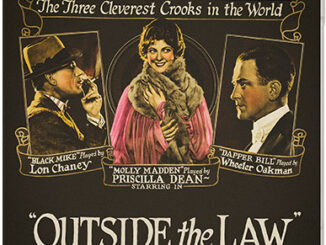

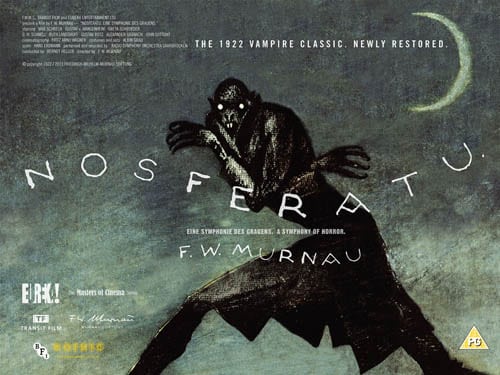
Be the first to comment